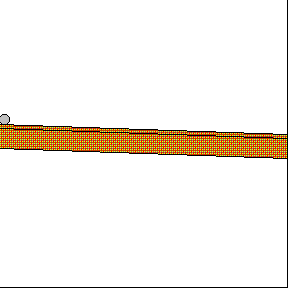M.2.2 Acceleration Down an Inclined Plane
| A four meter long track is available for Galileo's
"diluted gravity". Galileo argued that as the angle of incline of a track is
increased, the motion of a rolling ball approaches free fall, so that the motion of the
ball down the track is the same type of accelerated motion as free fall. This device is very useful when you are discussing uniformly accelerated motion and free fall because motion is slow enough on the track so you can describe it while it is happening. For example, you can simulate a ball thrown in the air by rolling a ball up the track while discussing how its velocity decreases on the upward leg, becomes zero at the top, and increases on the downward leg. |
The concept of acceleration can be demonstrated by rolling a ball down the inclined plane and marking its successive positions on drafting tape pasted to the track, timing the positions with metronone beats. The simplest way to do this is to have several positions marked before the class begins and add a few more during the class demonstration, while showing the students that the ball passes all the marks at the right times. Then by measuring the distances you can show that the total distance the ball rolls increases with the square of the time.
Galileo's experiment itself is likely to be obscure to the students, since it depends on knowing that the difference of successive square integers are the odd integers. It can be performed as follows: The tape pasted to the track is marked as before, or perhaps by a student volunteer with good reaction time and coordination. The tape is then cut at the marks and pasted onto the blackboard in the form of a bar graph. The ratios of the heights 1 : 3 : 5 : 7 : 9 .. . give the differences of the squares in the formula y = 1/2 at^2.
